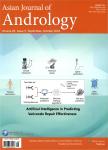Effects of plication procedures in special cases of Peyronie’s disease:a single-center retrospective study of 72 patients
作者机构:Department of Urology and AndrologyNinth People’s HospitalSchool of MedicineShanghai Jiaotong UniversityShanghai 200011China
出 版 物:《Asian Journal of Andrology》 (亚洲男性学杂志(英文版))
年 卷 期:2022年第24卷第3期
页 面:294-298页
核心收录:
学科分类:1002[医学-临床医学] 100210[医学-外科学(含:普外、骨外、泌尿外、胸心外、神外、整形、烧伤、野战外)] 10[医学]
基 金:supported by thegrant from the National Natural Science Foundation of China(No.81970656)
主 题:penile curvature Peyronie’s disease plication
摘 要:General recommendations regarding surgical techniques are not always appropriate for all Peyronie’s disease(PD)***,the purpose of this study was to investigate the effects of plication procedures in PD patients with severe penile curvature and the effects of early surgical correction in patients who no longer have progressive *** clinical data from 72 patients who underwent plication procedures were analyzed in this *** were divided into Groups A and B according to the curvature severity(≤60°or60°)and Groups 1 and 2 according to the duration of disease stabilization(≥3 months or3 months).At the 1-year follow-up,90.0%(36/40)and 90.6%(29/32)patients reported complete penile straightening,and 60.0%(24/40)and 100.0%(32/32)patients reported penile shortening in Groups A and B,*** curvature recurrence occurred in any patient,and no significant differences were observed in postoperative International Index of Erectile Function–Erectile Function domain(IIEF-EF),erectile pain,sensitivity,or suture knots on the penis whether such outcomes were grouped according to the curvature severity or the duration of ***,the duration from symptom onset to surgical management in Group 1 was significantly longer than that in Group 2(mean±standard deviation[s.d.]:20.9±2.0 months and 14.3±1.2 months,respectively,P0.001).The present study showed that the plication procedures seemed to be an effective choice for the surgical treatment of PD patients with severe penile *** addition,the early surgical treatment seemed to benefit those patients who already had no erectile pain and no longer exhibited progressive deformity.



